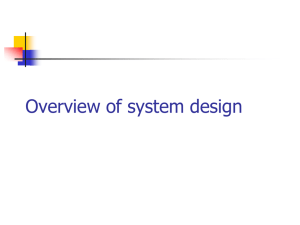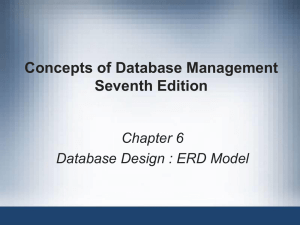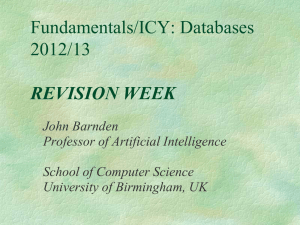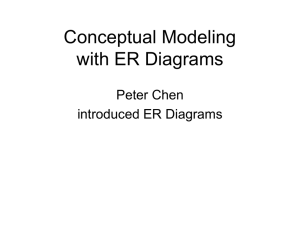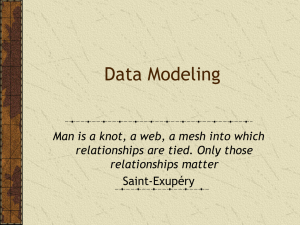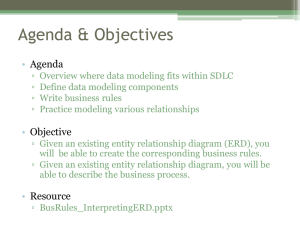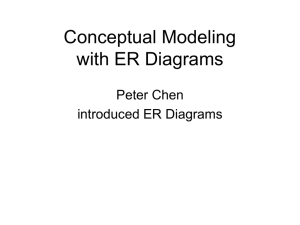database - Home - portalsainskomputerperak
advertisement
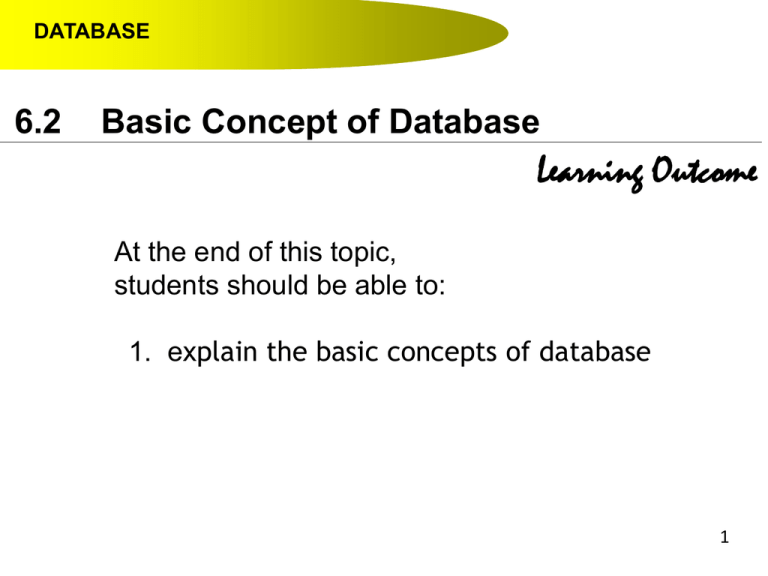
DATABASE 6.2 Basic Concept of Database Learning Outcome At the end of this topic, students should be able to: 1. explain the basic concepts of database 1 DATABASE 6.2 Basic Concept of Database 2 DATABASE 6.2 Basic Concept of Database 3 DATABASE 6.2 Basic Concept of Database Data Hierarchy 4 DATABASE 6.2 Basic Concept of Database ● Data Hierarchy – refers to the organization of data in a database. ● table/s or file/s ● record/s (in rows) ● field/s (in columns) ● character 5 DATABASE 6.2 Basic Concept of Database ● Data Hierarchy – a database contains one or more tables. A table contains a number of records. A record contains one or more fields. 6 DATABASE 6.2 Basic Concept of Database ● Data Hierarchy – a database files stored on disk (usually stored in the form of tables) , each files has its own records and each records has its own fields. 7 DATABASE 6.2 Basic Concept of Database 6.2 Basic Concept of Database Adding new contact in Samsung Galaxy S III DATABASE 6.2 Basic Concept of Database 1 1● touch on the Apps icon – 2● The one with rectangle grid touch on Contact icon 2 DATABASE 6.2 Basic Concept of Database 3 5 4 5 3 touch on plus symbol (+) to open up a new Create contact screen 4 User will able to see the Create contact screen, and fill in the Name’s field and etc and user have the option to add another field, such as Mobile, Home, Address, Email’s field and etc DATABASE 6.2 Basic Concept of Database 6 Explains • 6 touch on Save to keep the new contact (that you’ve just added) in your phone • • Contact Management features in any mobile phone is an example of database in your device (because it is an organized collection of data – your friend’s contact number stored in your phone) Create contact enable you to see many field (NAME, MOBILE, HOME .. ) – in that case it is a table with a lot of fields (depends on user to add or to remove fields) When you Save, you actually saving – a record in your phone. DATABASE 6.2 Basic Concept of Database Contact Management features in any mobile phone is an example of database in your device (because it is an organized collection of data – your friend’s contact number stored in your phone) Create contact enable you to see many field (NAME, MOBILE, HOME .. ) – in that case it is a table with a lot of fields (depends on user to add or to remove fields) When you Save, you actually saving – a record in your phone. DATABASE 6.2 Basic Concept of Database TABLE • • • • also known as database file/s. organized data in rows and columns. contain fields (column) and records (row). Data file – collection of related records, stored in any available storage medium. RECORD • • • • also known as rows. Contains data values (name for a person, of a product, an ID for student). a collections of related fields in a database. also represent a data attributes (describing an entity). FIELD • • • • • also known as a columns contains a specific category of data within a record. single category of data to be stored in database. field name – uniquely identifies each field. field size – defines the maximum of characters a field can contain. 13 DATABASE 6.2 Basic Concept of Database Table 14 DATABASE 6.2 Basic Concept of Database 15 DATABASE 6.2 Basic Concept of Database Field 16 DATABASE 6.2 Basic Concept of Database Data Dictionary and Data Type 17 DATABASE 6.2 Basic Concept of Database a *repository in database, contains data about files in the database and each field in those files - Shelly & Vermaat, 2012 DATABASE 6.2 Basic Concept of Database a *repository in the form of book, contains visual data and information about certain topics – SeAm 2014 DATABASE 6.2 Basic Concept of Database List 3-4 examples of data that can be extract from student. Imagine you are at the bus stop, suddenly one female student that you’ve already admire, walk to the bus stop and sit near you. Ok man, what will you do ? NAME PHONE NUMBER CLASS STATUS DATABASE 6.2 Basic Concept of Database Microsoft Access 2007 Table Design View Table Design View is Data Dictionary for MS Access 2007 DATABASE 6.2 Basic Concept of Database Microsoft Access 2007 Table Design View 1 2 Data Dictionary has a field name for DBA to set a name for specific field and for each Field Name DBA need to set the type of data (data values) for the field name 3 Descriptions is a brief information about field name Table Design View is Data Dictionary for MS Access 2007 DATABASE 6.2 Basic Concept of Database Microsoft Access 2007 Table Design View Data Type (in database) - specifies the kind of data a field can contain and how the field is used DATABASE 6.2 Basic Concept of Database DATA TYPE DESCRIPTIONS Text store data that is not manipulated arithmetically Number store numeric data, arithmetically can be manipulated (integer, decimal – are available) Currency special for numeric data that represents money (output with currency signs, decimal points and commas.) Yes/No store logical data, can only contains one from two-values (often appear as checkboxes) Date/Time store dates and times as values, can be sorted, added, or manipulated (has several formats to choose from) Memo store large block of text, can’t be arithmetically manipulated or compared, but can be edited and displayed. Hyperlink store hyperlinks to web pages, email addresses, or even a files. Attachment contains images, documents, other types of files supported by the DBMS program being used. List of Data Type commonly available in MS Access 2007 DATABASE 6.2 Basic Concept of Database Primary Key and Foreign Key 25 DATABASE 6.2 Basic Concept of Database Microsoft Access 2007 Primary Key in Table Design View Primary Key field in Table View 26 DATABASE 6.2 Basic Concept of Database Microsoft Access 2007 Primary Key in Table Design View Primary Key (in database) – a field, uniquely identifies each record in a file. • • • also known as a key field data (in the field) is unique. can be used to integrate data in database. 27 DATABASE 6.2 Basic Concept of Database Primary Key (PK) (in database) – should follow the listed rules (in order to use it in database) • • • Primary Key’s Symbol in Microsoft Access 2007 PK must contain a value – that is must be declared (NOT NULL). PK value must be unique for each record (row). PK value must no change or become NULL Benefits of using primary key (in database) ; • ensuring there’s no duplicate records in database. • preventing a NULL value being entered in unique field. 28 DATABASE 6.2 Basic Concept of Database Foreign Key (in database) – a field in relational table, that matches primary key column of another table. Explains 1 2 1 1st Table 2 2nd Table 3 3 Relational / Relationships Line Connecting 1st and 2nd Table Example of Relational Table in Microsoft Access 2007 29 DATABASE 6.2 Basic Concept of Database • Foreign Key (in database) – a field in relational table, that matches primary key column of another table. From the image, there are 2 tables. #1 Contact_Samsun.. And #2 is Hostel Info. Both has been connected, thus makes the table is a relational table. • In Table #1, Contact_Samsun… , field Matric_Num is the PK , and there are not Foreign Key in table 1. • In Table #2, Hostel Info, field Room Num is the PK (for that table), and Matric_Num is the Foreign Key (because it matches primary key form another table ,Table #1). Example of Relational Table in Microsoft Access 2007 Remember ! Explains 30 DATABASE 6.2 Basic Concept of Database Conclusions Example of Relational Table in Microsoft Access 2007 Remember ! A foreign key (sometimes called a referencing key) is ; • key used to link two tables together. • taking primary key field from one table and insert it into the other table (where it becomes a foreign key ). Foreign Key (in database) – a field in relational table, that matches primary key column of another table. 31 DATABASE 6.2 Basic Concept of Database 32 DATABASE 6.2 Basic Concept of Database 33 DATABASE 6.2 Basic Concept of Database Primary Key & Foreign Key Differences of primary key and foreign key; primary can contain only unique value while foreign key may contain duplicate value. Importance of relationship between the Primary Key and Foreign Key ● the primary key of one table becomes a foreign of other table (by matching a foreign key with a primary key, there is no need to enter data repeatedly) ● making the process (query, form, reports) easier. ● improves data performance by relating smaller tables into meaningful databases. 34 DATABASE 6.2 Basic Concept of Database Entity Relationship a data model that describes data and information, implemented in a relational database. 35 DATABASE 6.2 Basic Concept of Database Entity Relationship • something of importance to the organization. • an association between data that's stored in different record types. • entities that the organization wants to store data about typically becomes a database table. • important because typically describes an association between two or more entities. • Cardinality person, place, object, event or concept in the user environment • important aspect of the relationship about which the organization wishes between record types. to maintain data. • number of associations that can exist “thing” or object that contain data. between two record types. represented by a rectangle in E-R Attributes (entity-relationship) diagrams • characteristic of an entity. • • • property of an entity set 36 DATABASE 6.2 Basic Concept of Database TERM EXAMPLES Entity (a noun) Product, Name, Book, Student, Model, Lecturer, Staff. Relationship (a verb) order, register, claim, enroll, pay. Cardinality (type of relationship) One-to-One (1:1) One-to-Many (1:M) Many-to-One (M:1) Many-to-Many (M:N) Attribute (entity’s property) product_serial_num, product_price, product_name, 37 DATABASE TERM DIAGRAM SYMBOL Entity (a noun) rectangle/square Relationship (a verb) a diamond shape Cardinality (type of relationship) writing type of relationship on each relationship lines 1 1 example : one-to-one, 1:1 Attribute (entity’s property) an oval shape 38 DATABASE 6.2 Basic Concept of Database Identify • • • • Example of ER-Diagram (Entity-Relationship Diagram) How many entity are there in the ER-diagram ? Which entity has the most attributes ? List the attributes for entity label Mark What is the relationship between Student and Teacher ? 39 DATABASE 6.2 Basic Concept of Database Types of Entity-relationships (Cardinality) in database One-to-One (1:1) One-to-Many (1:M) Many-to-One (M:1) Many-to-Many (M:N) a record in one record type is related to one record in another record type when one record is related to many records (and vice versa) multiple record in a particular record type can be related to many records in another record type, and vice versa 1 1 M 1 M M N 1 40 DATABASE 6.2 Basic Concept of Database Example 1 2 entity, Teacher and Subject, the relationship is supervise, Cardinality is 1:1 1 Teacher 1 Example 2 2 entity, Student and Module, the relationship is enroll, Cardinality is 1:1 1 Student Subject supervise 1 enroll Module 41 DATABASE 6.2 Basic Concept of Database Example 1 Football Team 2 entity, Football Team and Player, the relationship is join, Cardinality is 1:M 1 M Example 2 2 entity, Person and Location, the relationship is birthplace, Cardinality is M:1 M Person Player join 1 birthplace Location 42 DATABASE 6.2 Basic Concept of Database Example 1 2 entity, Book and Author, the relationship is written, Cardinality is M:N M Book N Example 2 2 entity, Student and Course, the relationship is register, Cardinality is M:N M Student Author written 1 register Course 43
